

If a machine is used for a long time, there will always be some minor problems, so we must have a certain understanding of it, and some minor problems will be solved when they happen. The following editor will explain to you the solution when the circuit of the gasoline rock drill fails. I hope it can help you.
The gasoline rock drill is a rock drill powered by fuel combustion. It is a hand-held rock drill tool composed of a small gasoline engine, a compressor, and a rock drill. Mainly used for drilling down, horizontal and upward blast holes less than 45°, replacing a few parts, can be changed to a crusher or tamping machine, used for various shoveling, crushing, digging, splitting and tamping work . Because the machine has its own power and self-produced compressed air to blow the blasthole, it is especially suitable for high mountains, areas without power supply, and compressed air equipment, and temporary projects with high mobility. It is widely used in open-pit mining, excavation of frozen soil, road construction, cable laying and water conservancy construction, etc.
Solution when the gasoline rock drill circuit breaks down: The sign of the normal working of the circuit is: ground the spark plug shell connected to the high-voltage line on the machine. When the flywheel rotates, a strong, audible blue spark is emitted between the spark plugs. If the spark is weak, occasionally or not at all, it means that the circuit is malfunctioning.
Every element in the circuit may malfunction. Virtual connection or short circuit of the circuit, degradation of capacitor performance, component damage and improper adjustment, etc., all affect ignition. During maintenance, first remove the flywheel and spark plug, and check whether the spark plug is connected to the high-voltage line, whether the high-voltage line is damaged or leaking, and whether the breaker is damaged. If it is confirmed to be damaged, it needs to be replaced. Then remove the spark plug and the carbon and oil stains, and adjust the gap between the two and the gap to 0.6~0.7mm. Also remove the grease and ablation between the platinum. The connector of the high-voltage line of the sensor should not be too high, otherwise, the flywheel and the circuit will cause a short circuit or internal ignition, causing the spark plug to not ignite. At this time, you should loosen the sensor, turn the high-voltage line connector to the bottom, and then lock it. After that, use the flywheel ejector to suspend the flywheel on the crankshaft, adjust the platinum gap to 0.4~0.5mm, and then turn the flywheel to see if the spark plug ignites. If there is still no ignition or red sparks, remove the flywheel and remove the capacitor. Check with a multimeter. If the capacitor is broken down, leaked or short-circuited, it should be replaced. If necessary, check whether the internal winding of the inductor is open.


© Shandong China Coal Group. © 2016
Address:No. 11, North of Kaiyuan Road, High-tech Zone, Jining City, Shandong Province, China
Executive Editor: Linda Zhang